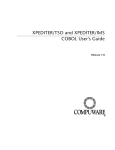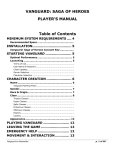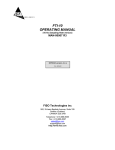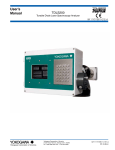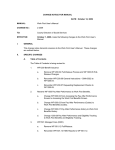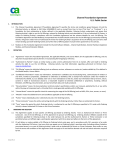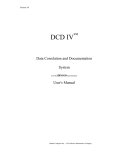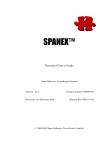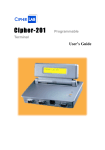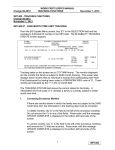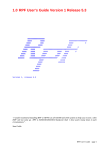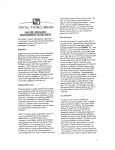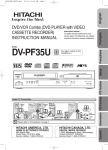Download System and method for bridging compliant and non
Transcript
US005911142A United States Patent [19] Smith et al. [54] Patent Number: Date of Patent: [11] [45] 5,911,142 Jun. 8, 1999 Primary Examiner—Paul R. LintZ SYSTEM AND METHOD FOR BRIDGING COMPLIANT AND NON-COMPLIANT FILES Assistant Examiner—John C. Loomis Attorney, Agent, or Firm—Price, Heneveld, Cooper, DeWitt [75] Inventors: Allan Michael Smith; Thomas L. Durnell, both of Cincinnati, Ohio & Litton [57] ABSTRACT [73] Assignee: Millennium Dynamics, Inc., Billerica, The system and method of the present invention automati Mass. cally converts ?eld lengths of data ?elds in a data ?le that are accessed by a computer program and correspond to date related data. Either the computer program or the data ?le [21] Appl. No.: 08/906,344 [22] Filed: Aug. 5, 1997 may be non-compliant. This function is carried out by providing a control program including parameters and com mands for converting the ?eld length of a date-related data Related US. Application Data Provisional application No. 60/051,451, Jul. 1, 1997. ?eld in the data ?le, inserting codes in the computer program ?le including a subroutine calling command such that the [51] Int. Cl.6 .................................................... .. G06F 17/30 control program Will be called and executed as a subroutine [52] US. Cl. ........................ .. 707/101; 707/102; 395/704; from Within the computer program ?le, executing the com puter program ?le, and executing the control program When [60] 395/712 [58] 707/102, 200; 395/701, 704, 708, 712 the computer program executes the subroutine calling com mand to automatically convert the ?eld length of a date References Cited order to alloW either inclusion or exclusion of the century in U.S. PATENT DOCUMENTS a portion of the data ?eld indicating the year prior to manipulation of the date-related data by the computer pro Field of Search ................................... .. 707/100, 101, [56] related data ?eld identi?ed by the computer program in 5,600,836 2/1997 Alter ..................................... .. 707/101 5,761,668 6/1998 Adamchick .. 5,794,048 8/1998 Brady ......... .. 5,809,500 9/1998 5,838,979 Nolan gram. The control program may be executed on-line or in batch When the computer program executes the subroutine 707/101 395/705 ....... . . . . . . .. calling command. The step of providing the control program 707/6 includes inserting ?le conversion parameters into a model control program to generate a control program ?le, and compiling the control program ?le to generate the control 11/1998 Hart et al. ............................. .. 395/707 OTHER PUBLICATIONS program. Vanatage YR200 User’s Manual Version 1.0, Millennium Dynamics, Inc., Dec. 1995 (This document Was supplied by 29 Claims, 3 Drawing Sheets applicant and is cited here to make the document of record). 1 15 120 V / L/ / L, / FILE CONVERSION / .1 PARAMETERS / /' Y I,/ YEAR3O00 / MODEL // /, / / PROGRAM / / 1 1 0 mi YEAR3999 CONTROL PROGRAM G EN ERATO R I CUSTOMER I PROGRAM ["160 CALL YEAR 2010 1 CONTROL I PROGRAM 1 FILE I COBOL COMPILE PROCEDURE BATCH LOGICAL BRIDGE CALL TO CONTROL PROGRAM TO CONVERT FILE CONTROL 1 150 PROGRAM WITH FILE CONVERSION PARAMETERS U.S. Patent Jun. 8, 1999 Sheet 1 of3 5,911,142 :22 RAM HARD DRIVE /36H M NO INTERFACE FIG. 1 U.S. Patent 115 Jun. 8, 1999 Sheet 2 of3 120 1 F'I-E YEAR3000 CONVERSION PARAMETERS MODEL PROGRAM 1 1O 5,911,142 100 ‘ wiL YEAR3999 CONTROL CUSTOMER PROGRAM PROGRAM GENERATOR 130 //f ‘L ‘\ CALL YEAR 2010 \\—* BATCH LOGICAL BRIDGE CONTROL if i ’ PROGRAM FILE \»~ 140\ CALL TO CONTROL // PROGRAM TO 1 CONvERT FILE *Jh— (giABsLLE PROCEDURE ‘CONTROL V 1% PROGRAM WITH FILE CONVERSION PARAMETERS FIG. 2 150 U.S. Patent Jun. 8, 1999 Sheet 3 of3 115\ / 220 FILE CONVERSION PARAMETERS 110 \ 5,911,142 YEAR3011 MODEL PROGRAM \/ 200 _; YEAR3999 CONTROL PROGRAM CUSTOMER PROGRAM GENERATOR - /26O CALL YEAR 2030 230 ' \ \.\u,/ ON-LINE LOGICAL BRIDGE CONTROL PROGRAM FILE CALL TO CONTROL PROGRAM TO 14O\ T if CONvERT FILE & r CCgC§ABPCIDLLE W PROCEDURE CONTROL PROGRAM WITH FILE CONVERSION PARAMETERS FIG. 3 250 5,911,142 1 2 SYSTEM AND METHOD FOR BRIDGING COMPLIANT AND NON-COMPLIANT FILES SUMMARY OF THE INVENTION Accordingly, the present invention has been made to overcome the above problems. One aspect of the present invention is to provide a method for automatically convert ing the data ?eld lengths in a non-compliant component of CROSS-REFERENCE TO RELATED APPLICATION This application claims priority under 35 U.S.C.§ 119(e) a computer program corresponding to the year from tWo characters to four characters and to insert or delete “19”, on US. Provisional Application 60/051,451 entitled “SYS TEM AND METHOD FOR BRIDGING COMPLIANT AND NON-COMPLIANT FILES” ?led on Jul. 1, 1997, by Allan Michael Smith and Thomas L. Durnell, the entire 10 disclosure of Which is incorporated by reference herein. a computer-implemented process that may be called from Within a compliant program to temporarily convert non BACKGROUND OF THE INVENTION The present invention generally relates to a method for converting data ?eld lengths in computer program ?les. compliant data for use by the calling compliant program. Yet 15 More particularly, the present invention relates to a computer-implemented method for converting data ?eld lengths in computer program ?les and/or databases for compliance With the next century. Presently, many businesses rely upon computer programs that generate and utiliZe date-speci?c data. Such computer programs include, for example, programs for maintaining a another aspect of the present invention is to provide a computer-implemented method that may be called from Within a non-compliant program to temporarily convert data from a compliant data ?le into non-compliant so that it may be read and manipulated by the non-compliant program. 20 database of insurance claims and dates on Which such claims Were made, and softWare used for tracking telephone calls in computing billing records. Because most of these computer programs have only used data ?elds having tWo characters “20”, “00”, or “99” into/from dates read from existing databases Where appropriate for use With compliant compo nents. Another aspect of the present invention is to provide A further aspect of the present invention is to provide a system for automatically converting data representing a speci?ed item of data, such as a date, telephone number, Zip code, social security number, etc., that may be found in program or data ?les. 25 To achieve these and additional aspects and advantages, the method of the present invention automatically converts ?eld lengths of data ?elds in a data ?le that are accessed by reserved for the year (i.e., Dec. 31, 1995), these computer a computer program and correspond to a date. The method programs assume that the year occurs in the tWentieth comprises the steps of providing a control program includ century and thus, Will not be able to distinguish betWeen dates occurring in this century and those occurring in the next century. For example, if the computer program gener 30 ates or accesses an invoice due date of “Jan. 1, 2000,” the program Will assume a due date of Jan. 1, 1900, even though Jan. 1, 2000, Was intended, and Will incorrectly designate the called and executed as a subroutine from Within the com 35 account as overdue and compute interest due on the account starting from the Jan. 1, 1900, date. Thus, it may be crucial for businesses to modify their existing computer programs for compliance With the next century. Although these computer programs could be modi?ed manually by going through each line of code of the programs ing parameters and commands for converting the ?eld length of a data ?eld corresponding to date-related data, inserting codes in the computer program ?le including a subroutine calling command such that the control program Will be puter program ?le, executing the computer program ?le, and executing the control program When the computer program executes the subroutine calling command. When executed, the control program automatically converts the ?eld length of a date-related data ?eld identi?ed by the computer 40 program in order to alloW either inclusion or exclusion of the and each segment of data in a database to make the neces century in a portion of the data ?eld indicating the year prior to manipulation of the date-related by the computer pro sary changes for compliance With the next century, such manual revision is tedious, very time consuming, and costly gram. The control program may be executed on-line or in batch When the computer program executes the subroutine and is subject to human error. Given the number of computer 45 programs presently used by businesses and the number of includes inserting ?le conversion parameters into a model control program to generate a control program ?le, and lines of code in such programs, there exists a need for an automated process for making necessary modi?cations in a computer program for compliance With the next century. The assignee of the present invention has developed a set compiling the control program ?le to generate the control program. 50 of computer-implemented tools for automatically converting the ?eld length of data relating to dates. These tools are used to convert all of one’s non-compliant program ?les and data ?les into ?les that are century compliant. HoWever, it may not alWays be desirable to convert all of one’s non compliant program ?les and/or data ?les. For example, one 55 compliant program to operate on non-compliant data With out having to permanently convert the data. Conversely, one program is not century compliant and must interact With 60 program to Work With compliant data. Therefore, there exists compliant data ?les, the identi?ed date-related data is copied into a temporary data record and the control program automatically deletes the existing century data from the a need for a bridging tool set that may be called from Within a compliant or non-compliant client program in order to alloW non-compliant program codes or data ?elds to be used With compliant program codes or data ?elds Without requir ing the non-compliant components to be permanently con verted. If the computer program is century compliant and must interact With non-compliant data ?les, a temporary data record is created, the identi?ed date-related data is copied from the non-compliant data ?le into temporary data record, the control program increases the ?eld length of the date related data ?eld in the temporary data record and then automatically inserts century data into the expanded date related data ?eld prior to manipulation thereof by the computer program. On the other hand, if the computer may Wish to use a neW, upgraded, or converted century may not Want to permanently convert a non-compliant calling command. The step of providing the control program 65 identi?ed date-related data ?eld in the temporary data record. The temporary data record is not Written back into the pre-existing data ?le unless the computer program has altered the date-related data or created neW date-related data that must be Written into the pre-existing data ?le. When data 5,911,142 3 4 that is changed or created by the computer program is to be Written back into the pre-existing data ?le, the control products marketed by Pansothic Corporation. Other product ?les similar to the PANVALET and PANEXEC ?les are ENDEAVOR- or LIBRARLAN-type libraries. The com program converts the data into either compliant or non puter programs to be converted may also include customer information communication services (CICS), Which is an compliant data by adding or deleting the century depending upon Whether the pre-existing data ?le is compliant or on-line product by IBM that supports multiple terminal non-compliant. interaction. The programs that run in this environment can The features and advantages of the invention may be realiZed and obtained by means of the instrumentalities and be TELON, Assembler, PL/I, or COBOL. The CICS envi ronment needs to knoW the names of the programs that are combinations particularly pointed out in the Written descrip alloWed to run in CICS, the names of the transaction codes, and What programs to execute When the transaction is typed in and What ?les are alloWed to be updated. This information for CICS is stored in system tables including program tion and claims hereof, as Well as the appended draWings. BRIEF DESCRIPTION OF THE DRAWINGS The accompanying draWings, Which are incorporated in, and constitute a part of, this speci?cation, illustrate several embodiments of the invention and together With the 15 The system of the present invention includes a computer hardWare used to implement speci?c functions. As noted description, serve to explain the objects, advantages, and principles of the invention. In the draWings: FIG. 1 is a block diagram illustrating the construction of a conventional personal computer in Which the present invention may be utiliZed; FIG. 2 is a How diagram illustrating an overvieW of the sequence of operations performed in accordance With the methodology of a ?rst embodiment of the present invention; and FIG. 3 is a How diagram illustrating an overvieW of the sequence of operations performed in accordance With the methodology of a ?rst embodiment of the present invention. above, these functions may be executed on a main-frame computer or mid-siZe computer. As discussed in more detail beloW, the system preferably includes means for generating 25 a control program including parameters and commands for converting the data ?eld length of date-related data in a data ?le, and means for executing the control program When a computer program executes a subroutine calling command that has been inserted Within the computer program ?le. The control program including means for automatically convert ing the data ?eld length of date-related data identi?ed by the computer program in order to alloW either inclusion or exclusion of the century in a portion of the data ?eld indicating the year prior to manipulation of the date-related DETAILED DESCRIPTION OF PREFERRED EMBODIMENTS As mentioned above, the present invention relates to computer softWare embodying a method for automatically converting existing computer program ?les and any associ ated data ?les for compliance With the next century. The computer softWare of the present invention may be utiliZed process tables (PPT), program control tables (PCT), and ?le control tables (FCT). 35 data by the computer program. In accordance With a ?rst embodiment, Which is described beloW With respect to FIG. 2, the control program is executed in batch When the computer program executes the subroutine calling com mand. In accordance With a second embodiment, Which is described beloW With respect to FIG. 3, the control program is executed on-line When the computer program executes the in a conventional mid-siZe computer or a main-frame com subroutine calling command. puter. A general overvieW of the construction of a conven tional computer 10 is illustrated in FIG. 1. PC 10 includes a central processing unit (CPU) 15 connected to a bus 17 to FIG. 2 illustrates an overvieW of the How of operations performed in accordance With a ?rst embodiment of the control the overall operation of computer 10. Computer 10 inventive methodology. The ?rst embodiment pertains to the implementation of the present invention With respect to a further includes a read only memory (ROM) 20, a random access memory (RAM) 22, a hard drive 24, a video driver 26 connected to a display monitor 28, and a ?rst I/O interface 30 connected to a keyboard 32. Also, computer 10 may optionally include a second I/O interface 36 and/or a modem batch customer program 100. Customer program 100 may be a century-complaint program that interacts With a non 45 compliant data ?le, or program 100 may be a non-compliant program that interacts With a compliant data ?le. To enable the compliant and non-compliant programs and data ?les to interact, the present invention provides a bridging routine 42. Preferably, RAM 22 is 8 MB or more and CPU 15 includes a processor having a speed greater than an Intel 386 processor. that Will present the data read from a non-compliant data ?le to a compliant program 100 as being compliant data (i.e., including the century in the date) or presents the data read The computer program ?les in Which the present inven tion Will convert its data ?eld lengths and code for compli from a compliant data ?le to a non-compliant program 100 ance With the next century, may take several forms and/or include date-speci?c data in many different formats and locations. Such computer programs may include various 55 as being non-compliant data. As described in more detail beloW, the bridging routines of the present invention are implemented by inserting codes combinations of copybooks; job control language (J CL) J ob Libraries; libraries of procedures invoked by JCL (PROC into customer program 100 including a subroutine calling Libraries); Source Libraries, Which may be Written in COBOL, TELON, Assembler, PL/I, or other languages; Copylib Libraries; and COBOL Source Panvalet or parti tioned data set (PDS) ?les. As Will be explained in more tine during the execution of customer program 100. Either command 160 that calls a control program 150 as a subrou control program 150 or the code inserted in customer program 100 copies the date-related data that is requested by detail beloW, the COBOL Source Panvalet or PDS ?les may customer program 100 from the data ?le into a temporary data record. The control program 150 then converts the ?eld include Panexec Load Libraries, Panvalet Source Libraries length of the data ?elds including any requested date-related and PDS Load Libraries, Panvalet Backup Source, Panvalet Test/Prod Source, COBOL PDS Source, and COBOL Pan valet Source. The “Panvalet” and “Panexec” ?les are those created and associated With the PANVALET and PANEXEC data to alloW for the inclusion or exclusion of the century 65 from the portion of the date-related data indicating the year. The converted date-related data is then presented to cus tomer program 100 for further manipulation. 5,911,142 6 5 folloWing items to the bridge betWeen the customer program 100 and the control program 150: the input record; the record siZe; the record format; the name of the customer’s record program that contains the conversion parameters; the code for inserting or sWapping back; the return code; and the returned record. If the application program 100 uses tables, Control program 150 is a program that is customized to operate With the particular customer program 100 With Which it must interact. Control program 150 is generated by the YEAR3999 control program generator 110, Which ?ts ?le conversion parameters 115 into the YEAR3000 model program 120 to produce a control program ?le 130. Control program ?le 130 is then compiled by a COBOL compiling procedure 140 to produce control program 150. The customiZation of control program 150 is enabled by the selection of particular ?le conversion parameters 115 that Will enable control program 150 to either expand the customer Would also pass the name of the table that corresponds to the table’s speci?c conversion parameters. Upon return to the customer’s program 100, the expanded or sWapped-back record is noW available to the customer date-related data ?elds in a non-compliant data ?le for use With a compliant program or to enable control program 150 to decrease the ?eld lengths of date-related data ?elds read from a compliant data ?le by a non-compliant program. 15 cated after each application input/output. In the examples YEAR3000 model program 120 is provided to alloW a programmer creating control program 150 to more easily construct control program 150 in a format that Will cooper ate With the recommended calling codes that are inserted into customer program 100. In particular, the calling codes inserted into the customer program 100 pass, in linkage, the program 100. These calling codes are preferably inserted into both the Working Storage and Procedure Division of customer program 100. Assuming the naming conventions are the same, the Procedure Division logic should be dupli that folloW, any names in loWercase need to be named speci?cally for the customer application. The folloWing 20 code is preferably inserted in the Working Storage of cus tomer program 100 to enable operation of the table bridge utility. The Table Bridge Utility requires the following elements in Working Storage 01 BINARY-NUMBER O1 BINARY-NUMB-X PIC S9(4) O1 05 BIN-NUM-1 O5 BIN-NUM-Z DYNC-YEAR201O O1 YEAR2010-CONTROL-INFO. PIC X(O1). PIC X(O1). PIC X(O8) VALUE ‘YEAR2010’. O5 YEAR2010-ACTION-CODE 88 88 O5 CONVERT-IT SWAP-IT-BACK 05 YEAR2010-RETURN-CODE YEAR2010-CONTROL-PROGRAM *** COMP. REDEFINES BINARY NUMBER. PIC X(O1). VALUE ‘C’. VALUE ‘S’. PIC X(O1). VALUE SPACE. PIC X(O8). VALUE ‘YEAR3---’ ****************************************************************** *** *** NOTE #1: BIN-NUM-Z is the record format lOW order byte. *** *** It ends up in YD-DCB-37 soon. *** *** NOTE #2: The VALUE ‘YEAR3———’ should be the name of *** *** the control program containing the SL/SW and Action Commands *** *** that Was created by YEAR3999. *** O1 *** ****************************************************************** YEAR2010-SEGMENT-DCB-INFO. O5 YEAR2010-IMS-SEGMENT *** PIC X(O8) VALUE SPACES. ****************************************************************** *** *** *** NOTE #3: Use YEAR2010-IMS-SEGMENT When there is absolute identify of a record segment or ?xed record. Use it only *** *** With the T=TABLENAME identi?cation technique. When using *** *** positional parameters, be sure it is blank. *** *** *** ****************$6********$6***9‘******$6***************************** O5 *** *** *** *** O1 O1 *** YEAR2010-DCB. 1O 1O 1O 1O 1O 1O 1O *** *** YD-DCB-O1-36 YD-DCB-37 FILLER YD-DCB-63-64 FILLER YD-DCB-83-84 FILLER PIC PIC PIC PIC PIC PIC PIC X(O36) X(OO1) X(O25) X(OO2) X(O18) X(OO2) X(116) VALUE VALUE VALUE VALUE VALUE VALUE VALUE SPACES. SPACES. SPACES. SPACES. SPACES. SPACES. SPACES. ****************$6********$6***9‘******$6***************************** NOTE #4: YD-DCB-37 is the record format lOW order byte YD-DCB-63-64 is the record lenght YD-DCB-83-84 is the block size ****************$6********$6***9‘******$6***************************** BIG-IN-RECORD PIC-32760 O5 BIG-IN-1000. 1O BIG-IN-600. 15 PIC X62760). REDEFINES BIG-IN-RECORD. BIG-IN-1-500. 2O BIG-IN-400. 25 BIG-IN-300. 3O BIG-IN-ZOO. 25 35 BIG-IN-1OO 35 FILLER 3O FILLER FILLER PIC PIC PIC PIC X(100). X(100) X(100). X(100). *** *** *** *** *** 5,911,142 -continued The Table Bridge Utility requires the following elements in Working Storage 1O 20 FILLER 15 FILLER FILLER PIC X(100). PIC X(100). PIC X(400) O5 FILLER BIG-OUT-RECORD O1 *** PIC X(31760). PIC X(32760) 969696*96*96*96*969696969696*96*96*9696*96*96*96*96*9696*96*96*96*96************************ *** *** Note #5: This should be adjusted based on the size of the *** *** record. Also, consider the RDW for variable lenght records. *** *** In the Procedure Division, we will move the record to one of *** *** the “big-in” records. To make this work most e?iciently, it *** *** should be tailored to the size of the record *** *** 969696*96*96*96*969696969696*96*96*9696*96*96*96*96*9696*96*96*96*96************************ *** 15 Further, the following logic should preferably be inserted into a program after the the I/O step. MOVE 128 *** TO BINARY-NUMBER. 969696*96*96*96*969696969696*96*96*9696*96*96*96*96*9696*96*96*96*96************************ *** *** Note #1: Use 128 for ?xed format. Use 80 for variable length *** *** records. *** *** 969696*96*96*96*969696969696*96*96*9696*96*96*96*96*9696*96*96*96*96************************ MOVE BIN-NUM-2 *** TO YD-DCB-37. MOVE <<Record/data length>> TO BINARY-NUMBER. MOVE BINARY-NUMB-X *** TO YD-DCB-63-64. TO YD-DCB-83-84. 969696*96*96*96*969696969696*96*96*9696*96*96*96*96*9696*96*96*96*96************************ *** *** Note #2: <<Record/data length>> should be the actual or *** *** “ballpark” record length. *** *** 969696*96*96*96*969696969696*96*96*9696*96*96*96*96*9696*96*96*96*96************************ MOVE ‘SEGMTOO1 ’ *** *** *** *** *** 969696*96*96*96*969696969696*96*96*9696*96*96*96*96*9696*96*96*96*96************************ *** Note #3: Use the speci?c name for the tablename from the SL/SW Action Group. Use spaces if the seletion or swaps is *** using positional parameters. *** *** 969696*96*96*96*969696969696*96*96*9696*96*96*96*96*9696*96*96*96*96************************ MOVE USERS-RECORD *** *** TO YEAR2010-IMS-SEGMENT. *** TO <<Big-In-Record>>. 969696*96*96*96*969696969696*96*96*9696*96*96*96*96*9696*96*96*96*96************************ *** *** Note #4: Move the appropriate size of the rede?ned record *** *** called BIG-IN-RECORD. It is inefficient to move a small user *** *** record into a large “big-in-record”. *** *** 969696*96*96*96*969696969696*96*96*9696*96*96*96*96*9696*96*96*96*96************************ CALL DYNC-YEAR201 O USING IF YEAR2010-RETURN-CODE = *** YEAR2010-CONTROL-INFO YEAR2010-TABLE-DCB-INFO BIG-IN-RECORD BIG-OUT-RECORD. SPACE PERFORM <users—logic—path> ELSE PERFORM NO-ACI‘ION-TAKEN-ROUTINE. (REFER TO THE ERROR CONDITIONS) <users—record> refers to the input record (the results of the I/O) <recsize> refers to the maximum customer’s record size. <cust rec pgm> refers to the program containing the conversion parameters <user—logic—path> refers to the application program The above examples when in customer program 100 provide the required information outlined above to bridge 160 for use by control program 150. The manner by which control program 150 uses this information to perform the desired conversion is described below following a general overview of the second embodiment of the present inven tion. program 200 is executed on-line in cooperation with a 55 slightly different control program 250 through bridge 260. Control program 250 is created by inserting ?le conversion parameters 115 into YEAR3011 model program 220 by YEAR3999 control program generator 110. The resulting control program ?le 230 is compiled in the same manner by COBOL compiled procedure 140 as in the ?rst embodiment FIG. 3 shows the general operation of the inventive method according to the second embodiment. This embodi to produce control program 250. The recommended logic code that should be inserted into the working storage of the customer program 200 (which is typically a CICS program) ment is similar to the ?rst embodiment except that customer is as follows: 60 5,911,142 9 O1 ** 01 10 WORK-YEAR2030. O5 O5 O5 05 DYNC-YEAR203O A-DUMMY A-SPACE CT R-YEAR203O PIC PIC PIC PIC X(O8) X(O1) X(O1) S9(O9) VALUE ‘YEAR2030’. VALUE SPACE. VALUE SPACE. COMP-3 VALUE +0. 05 YRZK-BINARY-X REDEFINES YRZK-BINARY. COMP. SIZE IS 20218 BYTES/CHARACI‘ERS YEAR2030-LINKAGE-20218. O2 YEAR2030-CONTROL-INFO. O5 YEAR2030-ACI‘ION-CODE 88 88 05 O5 O2 PIC X(O1) VALUE SPACE. PIC X(O8) VALUE ‘YEAR3———’ BIG-IN-DDNAME. O5 YEAR2030-CICS —TABLE 05 BI-DCB. BI-DCB-O1-36 BI-DCB-37 FILLER BI-DCB-63-64 FILLER BI-DCB-83-84 FILLER BIG-IN-RECORD BIG-10000 O5 BIG-IN-1000. 1O BIG-IN-600. 15 O5 VALUE SPACES. PIC PIC PIC PIC PIC PIC PIC X(O36) X(OO1) X(O25) X(OO2) X(O18) X(OO2) X(116) VALUE VALUE VALUE VALUE VALUE VALUE VALUE SPACES. SPACES. SPACES. SPACES. SPACES. SPACES. SPACES. PIC X(1000OO). REDEFINES BIG-IN-RECORD. BIG-IN-1-500. 2O O2 VALUE ‘C’. VALUE ‘S’. YEAR2030-RETURN-CODE YEAR2030-TABLE-PROGRAM 1O 1O 1O 1O 1O 1O O2 O2 PIC X(O1) VALUE ‘C’. CONVERT-IT SWAP-BACK BIG-IN-400. 25 BIG-IN-300. 3O BIG-IN-ZOO. 35 BIG-IN-1OO 35 FILLER 3O FILLER 25 FILLER 2O FILLER 15 FILLER 1O FILLER FILLER BIG-OUT-RECORD PIC PIC PIC PIC PIC PIC PIC PIC X(100). X(100). X(100). X(100). X(100). X(100). X(400). X(1000O). PIC X(1000O). The “BIG-IN” area should preferably be built according to the user’s movement of records. It should re?ect the siZe 40 of the record being moved. Rede?ning BIG-IN-RECORD to smaller siZe de?nitions reduces the compiler generation of spacing When moving records to BIG-IN-RECORD. BIG IN-RECORD and BIG-OUT-RECORD are de?ned as 10k in the YEAR2030 program. dure Division of the customer program 200 after the CICS I/O function: MOVE ‘TABLEOO1 ’ MOVE 128 MOVE YRZK-BIN-l MOVE <<<< users record length >>>> MOVE YRZK-BINARY-X control program includes certain scripting language includ ing Select (SL) and SWap (SW) Statements, Which provide the ability to select records to insert data or to sWap data out 45 of records, and Action Commands that de?ne What changes to make to the selected data. SELECT and SWAP have The folloWing logic is preferably inserted into the Proce *** ESTABLISH RECORD FORMAT AND SIZE The manner in Which the above codes inserted into customer programs 100 or 200 interacts With control pro gram 150 or 250 Will noW be described. In general, the speci?c. de?nitions for the scripting language. SELECT, represented by SL Statements, identify records to add cen tury or other data. SWAP, represented by SW Statements, TO YEAR2030-CICS-TABLE. TO YEAR203O TO TO TO TO YRZK-BINARY. BI-DCB-37. YRZK-BINARY. BI-DCB- 63-64 BI-DCB-83-84, EXEC CICS LINK PROGRAM(‘YEAR2030’) COMMAREA(YEAR2030-LINKAGE-20218) LENGTH(20218) END-EXEC. = SPACE IF YEAR2030-RETURN-CODE PERFORM USERS-LOGIC-PAT H ELSE PERFORM NO-ACI‘ION-TAKEN-ROUTINE. NO-ACTION-TAKEN-ROUTINE. 5,911,142 11 12 identify records to remove (swap out) century or other data. These statements identify records and assign them to spe ci?c Action Groups. Later, Action Commands de?ne the conversion activity to take on these Action Groups. In the bridging tool of the present invention, SL/SW Statements use tWo different techniques to identify data. The ?rst technique is a positional select/sWap Which is the most folloWing the positional parameter can be any length up to the end of the 80-position record. For example, in example (3), the positional parameter indicates to search for “NEW YORK” beginning in position 75. This eliminates the need to code each position individually. It is not necessary to check for “N” in 75, “E” in 76, “W” in 77, etc. The start and end of each selection statement preferably begins With a single tick (‘), for example, a ‘12+REC’. The (+) indicates an OR condition. Because the plus sign and the tick have common SL/SW identi?cation technique. Examples (1), (2), and (3) shoW positional Select and SWap Statements. They select data based on the values of speci?c positions in the record. The second technique is a table select/sWap Which 10 special meaning to this particular scripting language, the selection criteria, itself, should not contain‘ or +. For a table Works for on-line and batch bridges. Examples (4) and (5) select/sWap (examples (4) and (5)): positions 9—16 of the beloW shoW Select and SWap Statements that use the table technique. This statement provides the table or IMS segment name to a bridging control program (150 or 250). positional statement are ?lled With a “T=” folloWed by the table name and positions 17—80 are left blank. The “T=” 15 identi?es this Select or SWap Statement as a Table Com mand Which is folloWed by the table name. The literal 1234567890123456789012345678901234567890123456789012345 (1) SL 001 POOOO1'1+2+3' P000352‘ (2) SW 001 POOOO1'1+2+3' P000372‘ (3) SL 002 POOOO1'4+5' POOO75'NEW YORK‘ (4) (5) (6) (7) SL SW SL SW 003 003 999 999 description of the table statements in examples (4) and (5) are: (4) Select data and assign it to Action Group 003 When the 20 T=TABLENAME T=TABLENAME NOW NOW data is associated With a table or IMS segment named TABLENAME. (5) Select data and assign it to Action Group 003 for sWap back When the data is associated With a table or IMS segment named TABLENAME. The format of the coding for the exemplary SL/SW 25 Preferably, data is assigned uniquely to Action Groups. A Statements are as folloWs: record cannot be assigned to more than one Action Group. POS Contents De?nition It Will be assigned to the ?rst SL/SW Statement that iden ti?es the record. HoWever, different SL/SW Statements can assign different records to the same Action Group. When 1-2 SL or SW SL for adding data to the record. 30 record. 3-4 BLANK 5—7 ACTION GROUP 8-80 POSITIONAL The Action Group. This three position alphanumeric code matches the records selected by the SL/SW Statements to the Conversion Action Command that changes the data. Depending on the selection technique, there STATEMENTS are tWo Ways to code this area. The Action Group is provided in the SL/SW Statements to assign the records to these Action Groups. Action Group Codes tie Select Statements to Action Commands. The Action Commands de?ne the changes to make to the record. The positional statements in positions 8—80 may be coded in three different Ways. For a positional Select/SWap (examples 1, 2, and 3), positions 9—14 include a “P” fol loWed by the ?ve position location to begin checking in the data. For example, to begin checking for a value in position 10 of the data record, “P00010” is entered. In positions coding positional SL Statements, the positions typically match non-compliant copybooks, Whereas When coding SW Statements, the positions typically match compliant copy SW for swapping (removing) data from the 35 books. As noted above, Action Commands de?ne What changes to make to select data. There are ten different Action Commands. They are: A) INSERT/DELETE B) DELETE/INSERT 40 45 C) INSERT/DELETE A SINGLE CHARACTER D) INSERT/DELETE INTO A FIXED RANGE E) REPLACE CHARACTER STRINGS F) INSERT/DELETE CENTURY IN PACKED FIELD G) INSERT/DELETE CENTURY IN BINARY FIELDS H) INSERT/DELETE CENTURY IN AN OCCURS I) INSERT/DELETE CENTURY IN AN OCCURS DEPENDING ON 50 J) USER EXIT FUNCTIONS Internally, control program (150 or 250) strips off the 15—18 for a positional SL/SW Statement, the values to look for in the position are listed. Such a positional statement Whole record that is to be accessed by customer program (P0001, etc.) folloWed by the values to check may be repeated up to the length of the 80-byte record. The literal Action Commands. By taking this approach, the scripting description of the positional statement in examples (1), (2), (100 or 200). Then, it builds up (or doWn) based on the 55 and (3) are: language alWays uses the original location of the data. This simpli?es the coding of the Action Commands. For example, after taking one action on a record, it is not necessary to (1) Select data and assign it to Action Group 001 When “reposition” the description of the record for subsequent position 1 has a value of 1 or 2 or 3 and position 35 has action. Consider a record With a date in position 20 and 30. a value of 2. The ?rst action inserts century in position 20. Everything after the insertion shifts tWo positions to the right. HoWever, the second action still points to the original position 30, not (2) SWap data and assign it to Action Group 001 When 60 position 1 has a value of 1 or 2 or 3 and position 37 has a value of 2. the “relocated” position 32. Because the control program strips the Whole record, it is not necessary to adjust for each Insert/Delete action. (3) Select data and assign it to Action Group 002 When position 1 has a value of 4 or 5 and position 75 is the starting position for the value NEW YORK. The positional parameter (P00001, etc.) indicates the beginning position of the search. The selection statement 65 Most Action Commands can both add and delete data. If executed as part of a Select Statement (to add data), it adds data. If executed as part of a SWap Statement (to remove 5,911,142 13 14 data), it removes that added data. This simpli?es the use of apply. If the date ?eld has defaults such as zeros, nines, or blanks, the Window Command inserts zeros, nines, or blanks as appropriate. this scripting language for bridging. It allows a single set of Action Commands to be stored with their corresponding Select or Swap Statements. Aparameter in the J CL indicates The Format Command indicates which date formats apply and whether the data is character (zoned decimal), packed or binary. With packed or binary, the location of the year and whether the control program (150 or 250) should perform the actions based on Select or Swap Statements. Further, it is easy to switch ?les between their converted and uncon verted state with one set of Action Commands. Those Action Commands have a mirror-opposite impact depending on whether they are executed as part of a Select or Swap Statement. 10 ably used together. For example, when the date is 010615 that could be Jan. 6, 2015, or Jun. 15, 2001, depending on the date format. Supplying the format allows the Window The Insert/Delete Action Command is used to insert and delete data, such as century. For ?elds that are not dates, the inserted/deleted data can be binary, hex, character, etc. For ?elds that are dates, the dates should be character (zoned Command to identify and interrogate the appropriate ?elds 15 decimal) data. For packed and binary format date ?elds, the appropriate packed or binary Action Command should be to determine the appropriate value or defaults. When using the Window and Format Commands in connection with an Insert/Delete Action Command, the following format for columns 21-80 of that Action Com used. For non-date ?elds, this command inserts/deletes character, packed, and binary data. century within the date may not be apparent. The Format Command indicates where the year and century are in the date ?eld. The Window and Format Commands are prefer 20 The Insert/Delete Action Command inserts data when it matches a SL (select) record. This command deletes data when it matches a swap (SW) record. Note that the same mand is as follows: 21-22 Century Action Command has a completely different impact on a record, depending on whether it is executed on a Select or 25 a Swap Statement. The preferred format for an Insert/Delete Action Com mand is: values. 23 Blank 24-27 Window Command 30 CONTENTS DEFINITION Action Group The Action Group tying the Action 28-29 Blank 30 Curr. Size 29 also.) example, one record may have six date related insertions. The sequeuce indicates 11 Comma 12-16 Insert Point 31-32 Blank 33 New Size 40 (For two digits, use position 32 also.) 34-34 Blank 35-38 ZONE 43-48 Format Command The Format Command that describes the date format. This allows the File Converter to windowing is not used, this indicates the point to begin inserting data. determine where to put The century ?eld. Comma delimiter 50 Comma delimiter Data to insert or delete. Note the special requirements for the Window and Format Command. 55 There are two commands that may be used in combination with these Action Commands and affect the data that is inserted in positions 21-80. These commands include the Window Command and the Format Command. The Window Command provides the ability to use a logical approach to set the century in data. To use the Window Command, a target year is selected. The control program will then insert “19” when the value of the year ?eld is greater than or equal to the target year and “20” when the year is less than the target year. The Window Command also interrogates the content of the date ?eld and determines if default values The word ZONE describes the date as character (zoned decimal data). Use this for character data only. regardless of whether the date is YYMMDD or MMDDYY format. For non-date related insertions, or when 20 Comma 21-80 Data to insert For example, YY expanded to CCYY is 4, MMYY expanded to MMCCYY is 6. the data. Comma delimiter For date related insertions, enter the start Length of the data to insert/delete. Can be from 1 to 60 positions. For date ?elds, this is the size of the expanded, compliant ?eld. of the date ?eld (not necessarily the year in the date ?eld). For example, if a date ?eld starts in position 25, this should be 00025 17 Comma 18-19 Insert Length For date ?elds, this is the size of the non-compliant ?eld. For example, YY is 2, MMYY is 4. (For two digits, use position 35 record can have more than one action. For the order of execution. (01 is executed ?rst, 02 is executed second, etc.) Always code the sequences moving from left to right through description of LT25 is: Insert 19 (value in 21-22) unless the value of the year ?eld (identi?ed in pos 12-16) Blank Identi?es the sequence for changes. One LT Command such as LT25. The literal is less than 25, then insert 20. Command to one Select or Swap Statement. Sequence Always use 19. The Converter determines when to substitute ‘20’ or default 60 Valid format commands are: YYMMDD converts to CCYYMMDD YYMM converts to CCYYMM YYDDD converts to CCYYDDD MMDDYY converts to MMDDCCYY MMYY converts to MMCCYY DDMMYY converts to DDMMCCYY YY converts to CCYY YYWW converts to CCYYWW WWYY converts to WWCCYY (W = Weeks) (W = Weeks) 65 The following shows four examples of this command and the literal description of each command. 5,911,142 15 16 123456789012345678901234567890123456789012345678901230 (1) 001 01,00125,02,19 (2) 002 (3) 002 01,00025,02,19 LT45 6 8ZONE YYMMDD 02,00035,02,19 LT45 6 8ZONE MMDDYY (4) 002 02,00055,04,ERED (5) 003 O1,00001,60,THIS REPRESENTS THE 60 CHARS (1) When used With SL, for records identi?ed by Action Group 001, the ?rst item to perform is to go out to position 10 maintain the record length. The folloWing is a preferred layout for the Delete/Insert Action Command for use in connection With the inventive program. 125 and insert the tWo position character 19. When used With SW, for records identi?ed by Action Group 001, the ?rst item to perform is to go out to position 125 and delete the tWo position character 19. 15 (2) When used With SL, for records identi?ed by Action Group 002, the ?rst item to perform is to go out to position CONTENTS DEFINITION 1-3 Action Group The Action Group that ties this Delete Command to the SL or SW Command. 4-8 Blank 9-10 Sequence 25 and recognize that this is the start of a character date ?eld that currently occupies 6 positions in YYMMDD 20 When used With SW, for records identi?ed by Action Group 25 For example one record may have six date-related actions. The sequence indicates the order of execution. (01 is executed ?rst, 02 is executed second, etc.) 11 002, the ?rst item to perform is to go out to position 25 and recogniZe that is the start of a date ?eld containing character date (Zoned decimal, not packed ordinary) occupying 8 Comma Indicates the position in the record to begin the delete. 17 Comma 18-27 Blank 28-30 # to Delete Comma delimiter 35-40 DELETE 30 (3) Example 3 has a slight but important difference from example 2. In example 3, the de?nition is MMDDYY instead of YYMD. The position (in this case 35) still 35 40 positions 46-50 represented by the values 12345. The value script to: Identify this record and assign it to action group 001 Insert 19 in position 23 it stays 50 bytes. Ensure the script can sWap century out of position 23 for Group 002, the second item to perform is to go out to position 55 and insert the four position character FRED. bridging non-compliant programs. 45 from sequence 01) so you do not have to change the position of the ?elds. When used With SW, for records identi?ed by Action Group 002, the second item to perform is to go out to position 55 and delete the four position character FRED. The Converter Here is an example of this command. We have a 50 byte record With one date located in position 23. There is ?ller in Delete tWo positions of ?ller from the end of the record so (4) When used With SL, for records identi?ed by Action The Converter interprets any prior repositioning (such as 50 Ensure the converter leaves spaces and not loW values on the end of the sWapped-back record. This shoWs the data and the script to accomplish this. The script looks like this: 123456789012345678901234567890123456789012345678901230 interprets any prior repositioning (sequence 01) so you do (1) LV not have to change the position of the ?elds. (2) SL (3) SW (5) For SL, for records identi?ed by Action Group 003, the ?rst item to perform is to go out to position 01 and insert the sixty characters displayed. Spaces Will be inserted if POOOO1‘1’ POOOO1‘1’ (4) 001 01,00023,02,19 (5) 001 02,00049, 002 DELETE The literal description of this script is: identi?ed by Action Group 003, the ?rst item to perform (1) This LV Command tells the converter to leave spaces (not loW values) at the end of a record on a sWap back. is to go out to position 01 and delete sixty characters. The second Action Command is the Delete/Insert Action 60 data Without expanding the length of the record. After inserting century, this Delete/Insert Action Command can remove ?ller from the end of the record to maintain the 65 record length. When executed as part of a SWap Statement, this command inserts the ?ller data back into the record to 001 001 55 less than 60 characters are provided. For SW, for records Command Which is used to delete data When used With a Select Statement and to add data When used With a SWap Statement. Sometimes, it is necessary or desirable to convert Indicates the number of positions to delete. DELETE instruction for the File Converter. This command deletes data When executed as part of a Select and inserts data When executed as part of a SWap. 1 in the ?rst position identi?es the data. We need to Write the Where to put century. In example 2, the year and the start of the date ?eld Were the same. In example 3, the year and the start of the date ?eld are in different locations. AlWays refer to the start of the date ?eld. This is not necessarily the location of the year Within the date ?eld. Comma delimiter 12-16 Deletion Point century. refers to the start of the date ?eld. The tools looks at the format code to determine the location of the year, and Identi?es the sequence of the command. One record may have more than one action. format. The tool identi?es Where century should go based on the format. It inserts the tWo position character 19, except inserts 20 When the year is less than (LT) 45. Additionally, this command inserts Zeros, nines or blanks if that is the default value in the date ?eld. positions in CCYYMMDD format. The tool identi?es Where century is based on the format. It deletes the tWo position POS (2) Identify records for Select Action Group 001 Where position one has a value of 1. (3) Identify records for SWap Action Group 001 Where position one has a value of 1. (4) On a Select, for Words identi?ed as Action Group 001, the ?rst thing to do is go out to position 23 and insert the tWo position value ‘19’. On a SWap, go out to position 23 and delete the ‘19’. 5,911,142 17 18 Here are several examples of the Add a Character Command (5) On a Select, for records identi?ed as Action Group 001, the second thing to do is go out to position 49 and and their literal description: delete tWo positions. On a Swap, go out to position 49 and add tWo positions. 1 2 3 4 5 The original, non-compliant data looks like this: 5 1234567890123456789012345678901234567890123456789012345 (1) 001 01,00010 001 ADD C = 11 (2) 001 02,00011 001 ADD C = 9 1 2 3 4 5 12345678901234567890123456789012345678901234567890 1_ E 12345 The compliant data (after inserting century and deleting?positions g sWapped-back data: In the original data, it is 12345 to represent ?ve characters of ?ll. In the converted data it is Q to shoW the impact of the Delete command to keep the 50 position record length unchanged. 15 blanks (2) For records identi?ed by Action Group 001, the second item to perform is to go out to position 11 and add 9 in this position. (3) For records identi?ed by Action Group 002, the ?rst item to perform is to go out to position 50 and add 222 spaces. 20 25 Note the “C=” to identify the replacement characters is missing. This is leaves blanks. (4) For records identi?ed by Action Group 003, the ?rst item to perform is to go out to position 50 and insert the character X 10 times. The fourth Action Command is the Insert/Delete into a Fixed Range Action Command Which is similar to using the combination of the Insert (With Zone) and Delete Action command inserted tWo spaces When executed as part of a sWap. Note that it inserts spaces—it can not restore 30 Commands. The Insert/Delete into a Fixed Range Action Command Will insert century into a range When it is not desirable to expand that range. For example, When a NAME ?eld Was reused to hold dates but it Was not desirable to expand the NAME from 30 to 32 positions. This command inserts or deletes characters into a range by shifting and Was not used. The third Action Command is the Add/Delete a Character dropping data Within the range. Data falling outside the range is not displaced. For example, this command inserts/ deletes century in positions 10 and 11 Without affecting the position of data in positions 90 and 91. Because data at the Action Command, Which adds (or deletes) a single character to a record. When executed through a Select Statement, this Action Command adds characters. With a SWap Statement, this Action Command deletes characters. The Add/Delete end of the range is dropped to accommodate the neW Action Command may add or delete a single character once or up to 999 times. For example, this Action Command can add a single space or up to 999 spaces to a record. All added characters are preferably the same. For example, this Action Command can add (1) or (11) to a record, but in typical use does not add “19” to a record. The preferred format for the <- this leaves ADD C = X to perform is to go out to position 10 and add 1 in this In the sWapped back data it is 123 . . . to shoW hoW this the original ?ller data of 45. Also note that it may have left loW values instead of spaces if the LV Command ADD 010 position. 123.. Compare positions 49 and 50 in the original, converted and 222 (1) For records identi?ed by Action Group 001, the ?rst item its original record length. 1 01,00050 01,00050 10 from the end of the record) looks like this. Note that it maintains 1 2 3 4 5 12345678901234567890123456789012345678901234567890 1_ 1 996 1 23 The swapped back data looks like this: i 1 2 3 4 5 12345678901234567890123456789012345678901234567890 (3) 002 (4) 003 characters, this particular Action Command should only be used When the characters at the end of the range are ?ller. 40 The format for this Insert/Delete into a Fixed Range Action Command is as folloWs: Add/Delete a character Action Command is as folloWs: 45 P05 CONTENTS DEFINITION 1-3 Action Group The Action Group that ties this Comma 12-16 Start of Add Identi?es the sequence of the Action. The sequence indicates the order of execution. 4-8 Blank Blank # to add Blank ADD The Action Group that ties this Delete Command to the SL/SW Statement. Identi?es the sequence of the Action. The sequence indicates the order of execution. (01 is executed ?rst, 02 is executed second, etc.). 5O 11 Comma Comma delimiter. (01 is executed ?rst, 02 is executed 12-16 Range Start second, etc.). 18-19 Insert Length Length of the data to insert. 17 Comma delimiter 20 The starting position to begin adding/ deleting characters. 17-27 28-30 31-34 35-37 Action Group Blank 9-10 Sequence 11 CONTENTS DEFINITION 1-3 9-10 Sequence command to one Select Statement. 4-8 POS 55 Number of positions to add/delete. data. It does not add data on a sWap. 60 65 Comma Delimiter Data to insert (eg: 19) Space delimiter. 24-27 WINDOW 28-30 Range Window Command(eg: LT45). This is optional. The length of the range (that started in 31-34 35-40 41-42 43-47 48 be blank, hex or any character. (To insert hex, go into hex edit mode and enter the character.) Comma Comma delimiter 21-22 Insert Data 23 Blank Length ADD instruction for the File Converter. On a SWap back, this command deletes 38-42 Blank 43-45 C = n (n = any char) Provides the insertion character. For example C = X inserts X into the record. To insert blanks, leave 43-45 blank. It can Comma Starting position of the range (not the insert). the position identi?ed in columns 12-16) Blank INSERT Insert instruction for the File Converter. Blank YY Location The YY location Within the date ?eld. FORMAT When using the WINDOW command (in 24-27), enter the corresponding FORMAT code. Leave this ?eld blank When the WINDOW command does not apply. 49-53 YY Location Second YY date location Within the date ?eld. 54 FORMAT When using the WINDOW command (in 24-27), enter the corresponding FORMAT code. Leave 5,911,142 -continued POS -continued CONTENTS DEFINITION 1305 CONTENTS 4_8 Blank DEFINITION this ?eld blank When the WINDOW command does not apply. The format codes are: 1 2 3 4 : : = = YYMMDD YYMM YYDDD MMDDYY TO TO TO TO CCYYMMDD CCYYMM CCYYDDD MMDDCCYY 5 = MMYY TO MMCCYY 6 = DDMMYY TO DDMMCCYY ;jW 9 =WWYY 5 11 10 W TO WWCCYY FORMAT Comma Comma delimiter Comma 18-28 Blank When using the WINDOW command (in 24-27), enter the corresponding FORMAT code. Leave this ?eld blank When the WINDOW command The length of data to replace. On 5L, the maXlmum 1S 10 On SW, the maXiInuIn iS 20. 15 31 Blank 32-33 Replacement Length The length of the replacement data. 61-65 YY Location Fourth YY date ?eld. FORMAT Starting position of the data to replace. Comma delimiter 29-30 Length to Replace does not apply66 _ Identi?es the sequence of the Action. The sequence indicates the order of execution. (01 is executed ?rst, 02 is executed second, etc.). 12-16 Start of Replace 17 55_59 YY Location Third YY date ?eld 6O _ 9-10 Sequence On SL then maximum is 20 When using the WINDOW command (in 24-27), 0 5“; th enter the corresponding FORMAT code. Leave this ?eld blank When the WINDOW command does not apply. n 20 34 Blank 35-38 REPL ’ . . 10' e maxlmum 1S ' REPL Replace instruction for the File Converter. . . . Positions 49 and subsequent are optional. They apply only _ _ _ When there are multiple actions in the range. They do not apply When there 15 only one actlon 1n the ragge' Thls Opnon 25 43-52 Data to Re lace p This is the data to re lace on a SL. . . p This is the replacement data on a SW. 53_54 Blank 55-74 Replacement Data accommodates up to four separate actions in a range. The This is the replacement data on a SL. This is the data to replace On a SW_ inserts may use different date formats. Note that the FOR MATS (entered in 48, 54, 60 and 66) are one position numeric format codes. The ?fth Action Command is the Replace Action Command, Which is used to replace a 1-10 character string 30 Here are several examples of the Replace Command and their literal description: 1 2 3 4 5 6 123456789012345678901234567890123456789012345678901234567890123456 (1) 001 01,00005, 01 02 REPL C 19 (2) 001 02,00010, 03 03 REPL OLD NEW (3) 002 01,00010, 10 05 REPL ABCDEFGHIJ 12345 40 With a 1—20 character string When used With a Select Statement. With a SWap Statement, this Action Command replaces a 1—20 character string With a 1—10 character string. (1) On SL transactions, for records identi?ed by Action Group 001, the ?rst thing to do is go out to position 5 and This limitation as to the number of characters is for but one sequence. With multiple sequences, the number of charac 45 replace the data “C” With “19”. On SW transactions, for ters is virtually unlimited. Thus, multiple sequences using records identi?ed by Action Group 001; the ?rst thing to this command alloW replacing as many characters as needed. do is go out to position 5 and replace the data “19” With The Replace Action Command (REPL) changes/expands all “C”. records With an individual “item” to another “item.” When 50 (2) On SL transactions, for records identi?ed by Action there is a large series of changes, it may be more efficient to Group 001, the second thing to do is go out to position 10 use the Exit Action Command described beloW. As an and replace the data “OLD” With “NEW”. On SW example of its use When executed as part of a Select transactions, for records identi?ed by Action Group 001, Statement, the Replace Action Command replaces the data in positions 43-52 of the command line by the data in positions 55-74. When executed as part of a SWap Statement, the Replace Action Command replaces the data in positions 55—74 With the data in positions 43-52. The preferred format for the Replace Action Command is as 55 the second thing to do is go out to position 10 and replace the data “NEW” With “OLD”. (3) On SL transactions, for records identi?ed by Action Group 002, the ?rst thing to do is go out to position 10 and replace the data “ABCDEFGHIJ” With “12345”. On SW 60 folloWs: transactions, for records identi?ed by Action Group 002, the ?rst thing to do is go out to position 10 and replace the data “12345” With “ABCDEFGHIJ”. POS CONTENTS DEFINITION 1-3 Action Group The Action Group that ties this command to the SL or SL Statement. 65 Using Example (3), this revieWs the impact of the Replace Command on data. Assume that the data is ?fty position ?xed format and looks like this: 5,911,142 21 22 1 2 3 4 5 6 123456789012345678901234567890123456789012345678901234567890123456 OOOOOOOOOABCDEFGHIJOOOOOOOOOOOOOOOOOOOOOOOOOOOOOOO When executed as part of an SL, the Replace Command goes out to position 10 and replaces “ABCDEFGHIJ” With “12345”. After executing this command, the data looks like this: 1 2 3 4 5 6 123456789012345678901234567890123456789012345678901234567890123456 0000000001234500000OOOOOOOOOOOOOOOOOOOOOOOOOO Note that ABCDEFGHIJ is noW 12345. Also note that the record length is noW 45 and not 50. 20 When this same command is executed as part of a SW P05 CONTENTS DEFINITION transaction, the reverse happens. The Replace Command goes out to position 10 and replaces “12345” With “ABC 1-3 Action Group The Action Group that ties this command to Select Statement. DEFGHIJ” . This returns the data to it’s original con?gu 4-8 Blank ration and data length: 1 2 3 4 5 6 123456789012345678901234567890123456789012345678901234567890123456 OOOOOOOOOABCDEFGHIJOOOOOOOOOOOOOOOOOOOOOOOOOOOOOOO This command replaces character data only. It does not replace hex, packed, etc. HoWever, it can replace character -continued data in records that have non-character data imbedded in it. 35 P05 CONTENTS DEFINITION 9-10 Sequence Identi?es the sequence of the Action. The sequence indicates the order of execution. Be sure to consider the impact of the REPL Command on the key data for the SL and SW Statements. The folloWing is an example of this situation. The SL statement identi?es data by a “C” in position 6. The REPL Command replaces the C With 40 19. Therefore, the corresponding SW for this data must refer to “19” and not “C” in the key. (O1 is executed ?rst, O2 is executed second, 11 12-16 etc.). Comma Start of Date that depending the date format, it is not necessarily the start of the YEAR or Where century Will be inserted. 17 Comma 18-19 Data length 123456789012345678901234567890123456789012345678901230 SL 001 POOOOS‘C’ sW 001 POOOO6‘19’ 001 01,00006, 01 02 REPL c 19 Comma delimiter This is the start of the date ?eld. Note 45 20 21-22 23 24-27 Comma 19 Blank WINDOW Comma delimiter. Length of the data (not packed) to be inserted. For century, this is 02. Comma delimiter Century. The LTxx Window Command (Where xx is the target year). 50 In this example, the Action Group 001 for SL looks for “C” in position 6. On a sWap (SW) it looks for “19”. This is because the REPL Command changed the data used to ~ ~ identify the Action Groups. 55 The sixth Action Command is the Add/Delete Century to 28-29 Blank 30 COMP'3 length The packed length of the unconverted COMP-3 date ?eld. For example, 4 for YYMMDD COMP-3 dates. 31-34 Blank 35-40 PACKED 4348 Date Format Packed instruction for the File Converter. The FORMAT command describing the unconverted date ?eld. For example, YYMMDD a Packed Field Action Command. This Action Command is used to insert or sWap century from a packed (COMP-3) ?eld. This Action Command is preferably formatted to carry 60 Here are several examples of the Add Century to a Packed the necessary instructions to the control program. In particular, this Action Command includes the length of the COMP-3 ?eld, the format of the date, and a PACKED indicator. The control program adds/deletes the packed century to the appropriate place in the date ?eld and adjusts the ?eld siZe. The preferred format for the Add/Delete Century to a Packed Field Action Command is as follows: Field Command and their literal description: 2 3 4 5 1 12345678901234567890123456789012345678901234567890123 PACKED YYMMDD (1) 001 01,00010,02,19 LT45 4 PACKED MMDDYY (2) 002 01,00010,02,19 LT45 4 5,911,142 23 24 -continued -continued 52; 22; 8188833385313 3:: i 522% 5 CONTENTS necessarily the start of the YEAR or Where Comm Data length Comm 19 Comma delimiter Length of the data (not binary) to be inserted. 02' Century century Will be inserted. (1) We have a packed date ?eld in YYMMDD format. For records identi?ed by Action Group 001, the ?rst item to perform is to go out to position 10 (the start of the date ?eld) and add a tWo character 19 (add 20 if the year is less 10 than 45). This date ?eld occupies 4 positions packed and 17 18-19 20 21_22 23 is in YYMMDD format Blank 24-27 WINDOW (2) We have a packed date ?eld in MMDDYY format. For records identi?ed by Action Group 002, the ?rst item to target year) 28-29 Blank perform is to go out to position 10 (the start of the date 15 ?eld) and add a tWo character 19 (add 20 if the year is less 30 Binary length than 45). This date ?eld occupies 4 positions packed and 32-34 Blank Note the different format in these tWo examples. Although . The length Of the binary date ?eld For example, 4 for YYMMDD binary dates and two for YYMM binary dates‘ is in MMDDYY format. . The LTxx WindoW Command (Where xx is the 438:2 EINARY . ate Format _ _ _ f h _1 Bmary msmlcnon or t 6 F1 6 ginverter' The FORMAT command describing the the date ?elds start in the same location, the YEAR 15 located 20 unconverted date ?eld For example in different relative positions. By providing the format, the File Converter recognizes Where to insert the century ?eld. It is not necessary to provide the relative position of the YYMMDD ’ YEAR, just the position of the date and the format. In example (1), the converted date ?eld Will be CCYYMMDD. 25 Here are several examples of the Add/Delete Century to a In example (2), the converted date ?eld Will be MMDDC Binary Field Command and their literal description: CYY (3) We have a packed year-only ?eld (YY format). For records identi?ed by Action Group 002, the second item to perform is to go out to position 25 (the start of the date ?eld, and also in this case the start of the year) and add a tWo character 19 (add 20 if the year is less than 45). This 123456789012345678901234567890123456789012345678901230 30 (1) 001 (2) 002 (3) 002 O1,00010,02,19 LT45 O1,00010,02,19 LT45 O2,00025,02,19 LT45 4 4 2 BINARY BINARY BINARY YYMMDD MMDDYY YYMM date ?eld occupies 2 positions packed and is in YY format. The ?eld increases to a three position packed CCYY. 35 (4) We have a packed Julian date ?eld (YYDDD format). For records identi?ed by Action Group 003, the ?rst item to perform is to go out to position 10 (the start of the date ?eld) and add a tWo character 19 (add 20 if the year is less than 45). This date ?eld occupies 3 positions packed and than 45). This date ?eld occupies 4 positions, is in binary is in YYDDD format. The ?eld increases to a four position packed CCYYDDD. On a sWap (SW), these same Action Cornmands have the opposite effect. On a SW, it Will sWap out these centuries inserted With the SL. 45 The seventh Action Command is the Add/Delete Century to Binary and Computational Fields Action Command, YYMMDD format. (2) We have a binary date ?eld in MMDDYY format. For records identi?ed by Action Group 002, the ?rst item to perform is to go out to position 10 (the start ofthe date ?eld) and add a tWo character 19 (add 20 if the year is less than 45). This date ?eld occupies 4 positions, is in binary Which is used to add and delete century to a binary or MMDDYY format. (3) We have a binary ?eld in YYMM format. For records computational date ?eld. This Action Command carries the necessary instructions to the control program including the length of the binary ?eld, the format of the date, and a identi?ed by Action Group 002, the second item to perform is to go out to position 25 (the start of the date ?eld) and add a tWo character 19 (add 20 if the year is less BINARY indicator. The control program then adds or deletes the binary century in the appropriate place in the date ?eld While also expanding the binary ?eld length When necessary. The preferred format for this Action Command is (1) We have a binary date ?eld in YYMMDD format. For records identi?ed by Action group 001 the ?rst item to perform is to go out to position 10 (the start of the date ?eld) and add a tWo character 19 (add 20 if the year is less than 45). This date ?eld occupies 2 positions, is binary 55 as folloWs: and is in YYMM format. Note that the maximum value of a tWo position binary ?eld is 32,768. Inserting 19 and 20 into this date ?eld can produce the numbers 199912 and POS CONTENTS DEFINITION 1-3 Action Group The Action Group that ties this command to 4-8 Blank 200012. The size of these numbers requires the binary ?eld to be increased to four positions. The eighth Action Command is the Add/Delete Century one Select Statement. 9-10 Sequence With Occurs Records Action Command, Which adds or deletes century When there is a ?xed number of Occurs, With Identi?es the sequence of the Action. The sequence indicates the order of execution. (O1 a maximum of 999. The ?le can have ?xed or variable is executed ?rst, O2 is executed second, etc.). 11 Comma 12-16 Start of Date Comma delimiter This is the start of the date ?eld. Note that depending on the date format, it is not 65 records. Within an Occurs, each action should be coded in a sending order. The preferred format for this Action Com mand is as folloWs: 5,911,142 25 26 POS CONTENTS DEFINITION 1-3 Action Group The Action Group that ties this command to the SL or SW Statement. 4-8 Blank 9-10 Sequence Identi?es the sequence of the Action. The sequence indicates the order of execution. (01 is executed ?rst, 02 is executed second, etc.). 11 Comma 12-16 Start of Occurs 17 Comma 18-19 Data length 20 Length of the data to be inserted. For century, this is 02. Comma Comma delimiter 21-22 19 23 Comma delimiter This is the start of the table or the occurs. Five position numeric. Comma delimiter. Century. Blank 24-27 WINDOW The LTxx WindoW Command (Where xx is the target year). 28-30 # Occur The number of occurrences in the record table. Three position numeric 31-33 # Pos. in Occurs The number of positions Within a single occurs. Three position numeric. 34 Blank 35-40 OCCURS OCCURS literal — identi?es Occurs for the File Converter. 41-42 Blank 43-48 1st Action COL 43 The values in columns 43-48 vary based on the data and the action to take. Options are: CHARACTER BINARY PACKARD DELETE I B P D data position data position data position Within the occurs Within the occurs Within the occurs 44-46 data position Within the occurs 47 (start of year in the (start of date ?eld) date ?eld) data length data length data length data length 48 Format Code Format Code length of data to delete Format Code (start of date ?eld) 49-54 2nd Action When there is a second action Within the occurs; then 55-60 3rd Action When there is a third action Within the occurs, then 61-66 4th Action When there is a fourth action Within the occurs, then 67-72 5th Action When there is a ?fth action Within the occurs, then 73-78 6th Action When there is a sixth action Within the occurs, then these columns apply. these columns apply. these columns apply. these columns apply. these columns apply The format for the data in these columns follows the same pattern as for the ?rst occurs: Here it is documented based 9=WWYY TO WWCCYY in its relative position rather than the actual column: COL CHARACTER 1 I 2-4 data position BINARY PACKED DELETE B P D data position data position data position Within the Within the Within the occurs (start of year in the occurs (start of date ?eld) (start of date Within the occurs Here are several examples of the Add/Delete Century With an Occurs and their literal description: 123456789012345678901234567890123456789012345678901230 (1) 001 01,00041,02,19 LT45003010 OCCURS I002 1I006 1 (2) 002 01,00250,02,19 LT45007025 OCCURS P00127 (3) 003 01,00050,02,19 LT45003020 OCCURS I002 1B01041 occurs (1) For records identi?ed by Action Group 001, recognize date ?eld) ?eld) 5 Blank data length 6 Format Code Format Code Format Code data length data length length of 55 data to delete year is less than 45) in position 2 Where there is a YYMMDD date and again in position 6 Where there is The format codes are: 1=YYMMDD TO CCYYMMDD 2=YYMM TO CCYYMM 3=YYDDD TO CCYYDDD 4=MMDDYY TO MMDDCCYY 5=MMYY TO MMCCYY 6=DDMMYY TO DDMMCCYY 7=YY TO CCYY that there is an Occurs clause. The Occurs starts in position 41, there are three occurrences and each occur rence has ten positions. Insert a tWo character 19 (20 if the 60 another YYMMDD date. Do both of these date inserts for each of the three occurrences. (2) For records identi?ed by Action Group 002, recognize that there is an Occurs clause. The Occurs starts in position 250, there are seven occurrences and each occur 65 rence has twenty-?ve positions. Insert a packed 19 (20 if the year is less than 45) in position 1 Which is currently the start of a tWo position packed YY date ?eld. 5,911,142 27 28 (3) For records identi?ed by Action Group 003, recognize The format for the data in these columns follows the same pattern as for the ?rst occurs depending on. Here it is that there is an Occurs clause. The Occurs starts in position 50, there are three occurrences and each occur rence has tWenty positions. Insert the appropriate century value as character data in position 2, Where the date ?eld documented based in it’s relative position rather than the actual column: 5 currently is in FORMAT #1—YYMMDD. At position 10 COL INSERT BINARY insert the appropriate century value into the binary ?eld four Positions With a format of YYMMDD~ 10 The ninth Action Command is the Add/Delete Century 1 I 2-4 data position Within the B P data position data position for the Start for Start efthe _ _ _ _ “ _ I, _ _ occurs (start of the date date ?eld Within occurs to ?eld Within the Occurs the occurs start deleting 5 Blank data length data length 6 Format Cede Format Cede Format Code should be coded in ascending order. The preferred format for this Action Command is as folloWs: POS CONTENTS DEFINITION 1-3 Action Group The Action Group that ties this command to the SL or SW Statement. 4—8 Blank 9-10 Sequence Identi?es the sequence of the Action. The sequence indicates the order of execution. (01 is executed ?rst, 02 is executed second, etc). 11 Comma 12-16 Start of Occurs 17 Comma 18-19 Data length 20 Comma Comma delimiter This is the start of the table or the occurs. Five position numeric. Comma delimiter Length of the data to be inserted. For century, this is 02. Comma delimiter 21-22 19 23 Blank 24-27 WINDOW The LTxx WindoW Command (Where xx is the target year). 28-30 #Occurs The maximum number of occurrences in the record table. 31-33 #Pos. in Occurs The number of positions Within a single occurs. Three Century. Three position numeric position numeric. 34 Blank 35-36 OD 37-40 OD Value OD literal — identi?es Occurs Depending On for the File Converter. Position of the Occurs Depending On value. 41 OD Length Length of the Occurs Depending On data ?eld. 42 OD data The data ?eld de?nition for the Occurs Depending On data de?nition ?eld. Valid codes are: B = Binary P = Packed I = Zoned Decimal/Character 43-48 1st Action The values in columns 43-48 vary based on the data and the action to take. Options are: COL BINARY 43 CHARACTER I PACKARD DELETE B P D data position for data position for data position Within Within the occurs the start of the the start of the the occurs to begin (Start of year in date ?eld Within date ?eld Within delete. the date ?eld) the occurs the occurs 47 Blank data length data length length of data 48 Format Code Format Code Format Code delete length of data to delete 44-46 data position 49-54 2nd Action When a there is a second action Within the occurs, then 55-60 3rd Action When there is a third action Within the occurs, then 61-66 4th Action When there is a fourth action Within the occurs, then 67-72 5th Action When there is a ?fth action Within the occurs, then 73-78 6th Action When there is a sixth action Within the occurs, then these columns apply. these colunms apply. these columns apply. these columns apply. these columns apply. DELETE D data position Within the of year in the date held) Wlth Occurs Dependlng On Actlon Command> Whlch adds or deletes century When there is an Occurs Depending On. The depending on should be present in the record. Again, the ?le can have ?xed or variable records and each action 15 PACKED length of data to Length odfl ata to e ete 5,911,142 29 30 (1) On SL and SW transactions, for records identi?ed by The format codes are: Action Group 001, the second thing to do is go out to 1=YYMMD TO CCYYMMDD 2=YYMM TO CCYYMM 3=YYDDD TO CCYYDDD 4=MMDDYY TO MMDCCYY 5=MMYY TO MMCCYY 6=DDMMYY TO DDMMCCYY 7=YY TO CCYY 8=Y YWW TO CCY YWW 9=WW Y Y TO WWCCYY position 10 and replace the three positions of data With three positions of data supplied by the exit program YR2KPGM3. Although very speci?c examples are described above for various statements, parameters, commands, and formats for these statements, parameters, and commands, it Will be appreciated by those skilled in the art that various modi? 10 The tenth Action Command is the Exit Action Command, Which allows customers to invoke their oWn routines for handling some aspect of a ?le conversion. The Exit Action Command uses the same general coding technique as the other Action Commands and can be designed to Work With program. 15 The above description is considered that of the preferred embodiments only. Modi?cations of the invention Will occur to those skilled in the art and to those Who make or use the both Select and SWap Statements. As noted above, When there are a large series of changes, it may be more ef?cient to use the Exit Action Command than the Replace Action cations could be made to the formats and that other statements, parameters, or codes may be implemented. The particular formats listed are provided for purposes of example only and are formats that correspond to the state ments as used and manipulated by the inventive computer invention. Therefore, it is understood that the embodiments shoWn in the draWings and described above are merely for 20 Command. For example, the Replace Action Command is a great tool When changing ten product codes to ten different codes in a ?le. HoWever, When changing 10,000 product illustrative purposes and are not intended to limit the scope of the invention, Which is de?ned by the folloWing claims as interpreted according to the principles of patent laW, includ ing the Doctrine of Equivalents. codes, it may be more efficient to use the Exit Action Command. The Exit Action Command can eliminate the 25 need to code 10,000 individual Replace Action Commands The invention claimed is: 1. A method for automatically converting date-related data that is read from, or Written into, a data ?e under control of a computer program, the method comprising the steps of: (one for each product). The preferred format for an Exit Action Command is as folloWs: 30 providing a control program including parameters and commands for converting the ?eld length of a data ?eld that corresponds to date-related data; inserting codes in the computer program ?le including a subroutine calling command such that the control pro POS CONTENTS DEFINITION 1-3 Action Group The Action Group that ties this command gram Will be called and executed as a subroutine from to the SL or SL Statement. 4—8 Blank Within the computer program ?le; 9-10 Sequence Identi?es the sequence of the Action. The sequence indicates the order of execution. 35 (01 is executed ?rst, 02 is executed ?eld; second, etc.). 11 Comma executing the computer program ?le; creating a temporary data record having at least one data copying the identi?ed date-related data into a data ?eld of Comma delimiter 12-16 Start of Replace Starting position of the data to replace. 17 Comma 18-28 Blank Comma delimiter 29-30 Length to Replace On SL, the length of data to replace. On SW, the length of the replacement gram executes the subroutine calling command to auto data. the temporary data record in order to alloW either inclusion or exclusion of the century in a portion of the 31 40 the temporary data record; and executing the control program When the computer pro matically converting the ?eld length of the data ?eld of Blank 32-33 Replacement Length The length of the replacement 45 data ?eld indicating the year prior to manipulation of the date-related data stored therein by the computer data 34 Blank 35-38 EXIT EXIT instruction for the File Converter. 39-42 Program Exit Program Name. program. 2. The method as de?ned in claim 1, Wherein the control 50 program further performs the step of automatically inserting century data into the converted date-related data ?eld prior to manipulation thereof by the computer program. Here are several examples of the Exit Command and their literal description: 1 2 3 4 5 6 123456789012345678901234567890123456789012345678901234567890123456 (1) 001 (2) 001 01,00005, 02,00010, 01 02 EXIT 03 03 EXIT YR2KPGM1 YR2KPGM2 (1) On SL transactions, for records identi?ed by Action Group 001, the ?rst thing to do is go out to position 5 and 60 replace the one position of data With tWo positions of data supplied by the exit program YR2KPGM1. On SW program further performs the step of automatically deleting the inserted century data from the identi?ed date-related data transactions, for records identi?ed by Action Group 001, the ?rst thing to do is go out to position 5 and replace the tWo positions of data With one position of data supplied by the exit program YR2KPGM1. 3. The method as de?ned in claim 2, Wherein, if the computer program modi?es the date-related data, the control 65 ?eld after manipulation by the computer program. 4. The method as de?ned in claim 1, Wherein the com puter program further performs the step of automatically 5,911,142 31 32 deleting century data from the identi?ed date-related data ?eld prior to manipulation thereof by the computer program. a portion of the data ?eld prior to manipulation of the data by the computer program. 18. A system for automatically converting data ?eld 5. The method as de?ned in claim 1, Wherein the control program decreases the ?eld length of the date-related data ?eld in the temporary data record in order to delete the lengths of date-related data that are in a data ?le that is accessed by a computer program, the system comprising: century from the portion of the data ?eld indicating the year prior to manipulation of the date-related data by the com puter program. 6. The method as de?ned in claim 1, Wherein the control program increases the ?eld length of the date-related data ?eld in the temporary data record in order to alloW inclusion of the century in the portion of the data ?eld indicating the year prior to manipulation of the date-related data by the computer program. 7. The method as de?ned in claim 1, Wherein the com means for generating a control program including param eters and commands for converting the data ?eld length of date-related data ?elds in the data ?le, Wherein the 10 inclusion or exclusion of the century in a portion of the 15 inserted Within the computer program ?le. 19. The system as de?ned in claim 18, Wherein said means for generating a control program includes means for insert ing ?le conversion parameters into a model control program to generate a control program ?le that may be compiled to 8. The method as de?ned in claim 1, Wherein the com puter program is not century compliant and the data ?le accessed by the computer program is century compliant. temporary data record is deleted after the computer program has ?nished utiliZing the manipulated date-related data. 13. A method for automatically converting data ?eld lengths corresponding to speci?ed items of data that are in generate the control program. 20. The system as de?ned in claim 18, Wherein said 25 35 manipulation thereof by the computer program. 23. The method as de?ned in claim 22 further including the step of automatically inserts century data back into the converted date-related data ?eld if the computer program commands for converting the data ?eld length corre sponding to a speci?ed item of data in the data ?le; inserting codes in the program ?le including a subroutine calling command such that the control program Will be changes the date-related data prior to Writing the changed called and executed as a subroutine from Within the 45 matically convert the ?eld length of the speci?ed item of data that is identi?ed by the computer program in order to alloW for modi?cation of the item of data prior to manipulation thereof by the computer program. 55 25. The system as de?ned in claim 18, Wherein said converting means increases the ?eld length of the identi?ed date-related data ?eld in order to alloW inclusion of the century in the portion of the data ?eld indicating the year prior to manipulation of the date-related data by the com puter program. 26. The system as de?ned in claim 18, Wherein the computer program is century compliant and the data ?le accessed by the computer program is not century compliant. 27. The system as de?ned in claim 18, Wherein the computer program is not century compliant and the data ?le accessed by the computer program is century compliant. data by the computer program. data ?eld in order to alloW inclusion of a segment of data in date-related data back into the data ?le. 24. The system as de?ned in claim 18, Wherein said converting means decreases the ?eld length of the identi?ed date-related data ?eld in order to delete the century from the portion of the data ?eld indicating the year prior to manipu lation of the date-related data by the computer program. gram executes the subroutine calling command to auto 17. The method as de?ned in claim 13, Wherein the control program increases the ?eld length of the identi?ed converting means additionally automatically deletes century data from the identi?ed date-related data ?eld prior to a data ?le that is accessed by a computer program, the 14. The method as de?ned in claim 13, Wherein the control program is executed on-line When the computer program executes the subroutine calling command. 15. The method as de?ned in claim 13, Wherein the control program is executed in batch When the computer program executes the subroutine calling command. 16. The method as de?ned in claim 13, Wherein the control program decreases the ?eld length of the identi?ed data ?eld in order to alloW exclusion of a segment of data from a portion of the data ?eld prior to manipulation of the converting means additionally automatically inserts century data into the converted date-related data prior to manipula tion thereof by the computer program. 21. The system as de?ned in claim 20, Wherein said converting means additionally automatically deletes the inserted century data from the identi?ed date-related data ?eld if the computer program changes the date-related data prior to Writing the changed date-related data back into the data ?le. 22. The system as de?ned in claim 18, Wherein said method comprising the steps of: providing a control program including parameters and program ?le; executing the computer program; and executing the control program When the computer pro data ?eld indicating the year prior to manipulation of the date-related data by the computer program; and means for executing the control program When the com puter program executes a subroutine calling command puter program is century compliant and the data ?le accessed by the computer program is not century compliant. 9. The method as de?ned in claim 1, Wherein the control program is executed on-line When the computer program executes the subroutine calling command. 10. The method as de?ned in claim 1, Wherein the control program is executed in batch When the computer program executes the subroutine calling command. 11. The method as de?ned in claim 1, Wherein the step of providing the control program includes inserting ?le con version parameters into a model control program to generate a control program ?le, and compiling the control program ?le to generate the control program. 12. The method as de?ned in claim 1, Wherein the control program includes means for automatically con verting the data ?eld length of date-related data iden ti?ed by the computer program in order to alloW either 65 28. The system as de?ned in claim 18, Wherein the control program is executed on-line When the computer program executes the subroutine calling command. 29. The system as de?ned in claim 18, Wherein the control program is executed in batch When the computer program executes the subroutine calling command. * * * * *




















